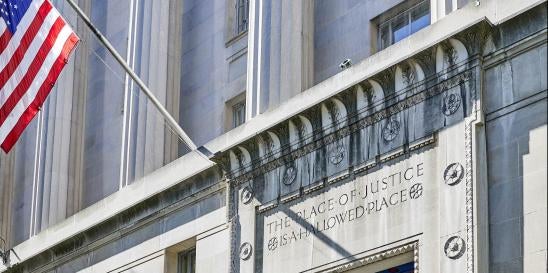On December 18, 2023, the U.S. Department of Justice Antitrust Division (DOJ) and Federal Trade Commission (FTC) (together, the Agencies) released a significant revision and expansion to the federal Merger Guidelines (the Revised Guidelines), the document that lays out the framework for how the Agencies will analyze mergers for potential antitrust concerns. Among many other changes, the Revised Guidelines introduce labor effects into merger analysis, expand the Agencies’ scrutiny of cumulative “rollup” transactions, and adopt a bright-line (but rebuttable) presumption against horizontal mergers that result in a market share above 30%. The Revised Guidelines are effective immediately, replacing both the Obama-era Horizontal Merger Guidelines from 2010 as well as the Trump-era Vertical Merger Guidelines from 2020 (the latter of which had already been withdrawn by the FTC).
The release of the Revised Guidelines represents the culmination of a nearly two-year effort by the Agencies to reexamine the earlier guidelines. The Agencies’ effort followed a 2021 Executive Order signed by President Biden, which called on the Agencies to “address the consolidation of industry” through strengthened antitrust enforcement in merger reviews. In this spirit, the Revised Guidelines represent a substantial expansion of the standards for reviewing mergers for potential antitrust concerns. The Revised Guidelines adopt six general principles for reviewing mergers under the antitrust laws:
- Principle 1: Mergers are presumed to violate the law if they “significantly increase concentration in a highly concentrated market.” The Revised Guidelines define a “highly concentrated” market as any market with a Herfindahl-Hirschman Index (HHI) above 1,800 — a substantial change from the 2010 Horizontal Merger Guidelines, which had defined highly concentrated as an HHI above 2,500. The Revised Guidelines adopt a rebuttable presumption that any merger that results in an HHI of 1,800 or greater, plus a change in HHI of 100 or greater, will be found unlawful under this principle. The Revised Guidelines also adopt a separate, rebuttable presumption that any merger that results in a combined firm with a market share above 30%, plus a change in HHI of 100 or greater, also will be found unlawful under this principle.
- Principle 2: Mergers can violate the law if they eliminate “substantial competition” between the merging parties. In other words, even in markets that are not highly concentrated, the Agencies’ position is that a merger between “substantial” competitors can nevertheless violate the antitrust laws.
- Principle 3: Mergers can violate the law if they “increase the risk of coordination,” i.e., if they facilitate collusion or tacit coordination among market participants. In this respect, the Agencies will consider whether a given industry is generally conducive to coordination, e.g., if it is highly concentrated, if it has a history of actual or attempted collusion, or if pricing decisions are readily observable by rivals.
- Principle 4: Mergers can violate the law if they “eliminate a potential entrant in a concentrated market.” In other words, even if one (or both) of the merging companies does not currently compete in a particular market, the Revised Guidelines warn that the law can be violated if that company has a reasonable probability or appearance of competing in that market in the future.
- Principle 5: Mergers can violate the law if they result in a firm that “may limit access to products or services that its rivals use to compete.” This principle would most commonly apply to “vertical” mergers, i.e., where a customer combines with a supplier.
- Principle 6: Mergers can violate the law if they “entrench or extend a dominant position.”
In addition to these general principles, the Revised Guidelines also address particular scenarios where these principles may come into play. For example, the Revised Guidelines consider whether the transaction at issue is “part of a series of multiple acquisitions” — reflecting an increasing trend by the Agencies to consider the “cumulative effect” of serial acquisitions or, as they are sometimes called, “rollups.” In addition, even where the merging parties themselves have not engaged in a series of multiple acquisitions, the Revised Guidelines also consider whether the overall “industry” has seen a trend toward consolidation, vertical integration, or any other sort of “arms race” among participants.
More broadly, the Revised Guidelines also consider whether transactions will impact competition for workers or suppliers (e.g., by unreasonably reducing wages or input costs), whether transactions might impact competition between or within multisided “platforms” (e.g., operating systems or marketplaces), or whether acquisitions of noncontrolling, minority interests may impact competition by distorting competitive decision making or incentives.
Although the Revised Guidelines represent a significant expansion of the Agencies’ framework for reviewing mergers, it is worth noting that the Agencies stop short of some of the more controversial changes that they proposed in the draft version of the Revised Guidelines (the “Draft Guidelines”) released in July. For example:
- The Draft Guidelines had proposed a presumption of illegality for “vertical” mergers where either company has a market share above 50%. While this concept remains in the final Revised Guidelines, the final version reduced the concept from the main text of the Guidelines down to a footnote and softened the 50% threshold from a strong presumption into a more general “infer[ence].”
- The Draft Guidelines had proposed a presumption of illegality for mergers that have the effect of “entrenching or extending an already dominant position,” with a market share of 30% or greater being one way to determine a “dominant position.” The Revised Guidelines do away with the presumption that a 30% market share constitutes “dominant.” Instead, the Revised Guidelines provide generally that mergers can violate the law if they have the effect of entrenching or extending a “dominant” market position, with dominance determined “based on direct evidence or market shares showing durable market power,” without specifying any particular share threshold that raises a presumption of illegality.
In summary, the Revised Guidelines represent a significant milestone in the Biden Administration’s efforts to strengthen antitrust enforcement. The Revised Guidelines send a strong message that the Agencies will use the antitrust laws aggressively to police merger activity. What remains to be seen, however, is to what extent the Revised Guidelines, which are not legally binding, will be accepted by courts.









 i
i


